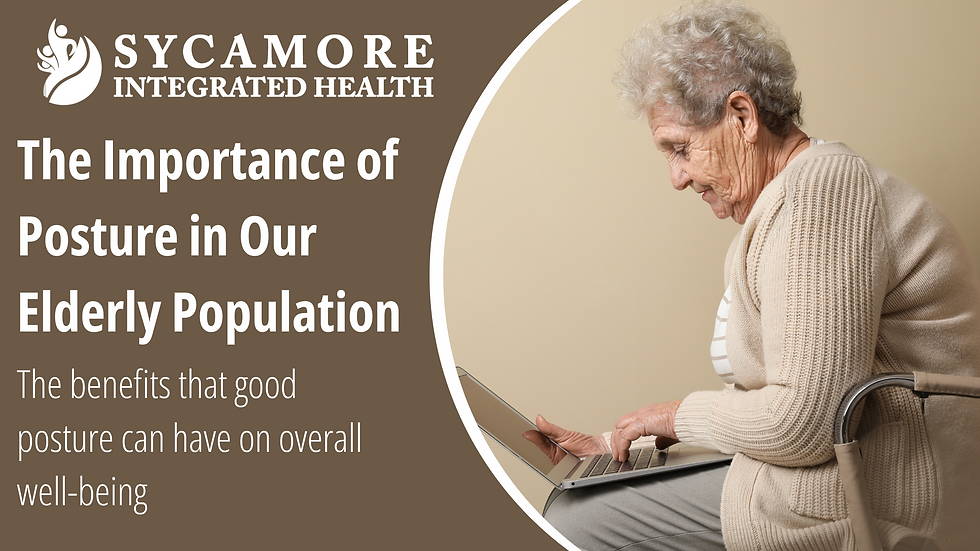Fall Prevention Guidelines for Seniors: A Chiropractic Approach
- Michael Coulibaly
- Aug 29
- 4 min read

Falls are a leading cause of injury and disability in elderly adults and can even cause death, but many are preventable. At Sycamore Integrated Health, we can create care plans to improve balance, coordination, joint mobility, strength, daily functionality, and overall nervous system function and that includes empowering seniors to maintain their independence longer and reduce their risk of falls. We will go over common fall risk factors, practical guidelines for seniors, and the benefits of a chiropractic care plan in fall prevention.
I. Understanding Fall Risk Factors
Many factors can increase the risk of falls in seniors. Recognizing these is the first step towards prevention:
Physical Factors:
Muscle weakness, especially in the legs and core.
Impaired balance and coordination.
Gait abnormalities (changes in walking style).
Reduced flexibility and joint mobility
Vision changes (e.g., cataracts, glaucoma, outdated prescriptions).
Foot pain or improper footwear.
Dizziness or vertigo.
Neuropathy (numbness or tingling, especially in extremities)
Chronic health conditions (e.g., diabetes, Parkinson's).
Medication Factors:
Side effects of certain medications and polypharmacy (taking multiple medications) increase the risk of adverse interactions and potential dizziness or drowsiness.
Environmental Factors:
Clutter, loose rugs, electrical cords.
Poor lighting, especially in hallways, stairs, and bathrooms.
Slippery surfaces (e.g., wet floors, uncarpeted stairs).
Lack of handrails or grab bars.
Unstable furniture.
Behavioral Factors:
Fear of falling, leading to reduced activity and further weakness.
Rushing or hurrying.
II. Practical Guidelines for Seniors
Beyond chiropractic care, implement these practical home safety and personal health strategies to reduce fall risk:
A. Home Safety Modifications:
Clear Pathways: Remove clutter, loose rugs, electrical cords, and other tripping hazards from all walking areas. Secure rugs with double-sided tape or non-slip backing.
Adequate Lighting: Ensure all areas are well-lit. Use brighter bulbs, install nightlights in bedrooms, bathrooms, and hallways, and ensure light switches are easily accessible at room entrances and at the top and bottom of stairs.
Stairs and Steps:
Install sturdy handrails on both sides of stairways.
Ensure good lighting for all steps.
Consider non-slip treads on bare wood steps.
Repair loose or uneven steps/carpeting immediately.
Bathrooms:
Install grab bars near the toilet and inside the shower/tub.
Use non-slip mats or strips in the shower/tub.
Consider a raised toilet seat or a bath seat for showering.
Kitchen: Store frequently used items on lower, easy-to-reach shelves. Use a sturdy step stool with a handrail if needed, and never a chair. Clean up spills immediately.
Furniture: Arrange furniture to create clear, wide pathways. Ensure chairs and sofas are easy to get in and out of.
B. Personal Health and Lifestyle:
Regular Exercise: Engage in exercises that improve strength, balance, and flexibility. Consult your chiropractor or other healthcare provider for appropriate exercises, which may include:
Walking
Tai Chi or Yoga
Single-leg stands (holding onto a sturdy object initially)
Heel-to-toe walking
Chair sit-to-stands
Ankle strengthening exercises
Medication Review: Discuss all your medications (prescription, over-the-counter, and supplements) with your doctor or pharmacist. Ask if any medications could increase your fall risk or cause side effects like dizziness. Do not stop taking prescribed medication without medical guidance from a licensed healthcare professional.
Vision Checks: Have your eyes checked by an eye care professional at least annually and ensure your eyeglass prescriptions are up-to-date. Be cautious with bifocals/progressive lenses on stairs.
Proper Footwear: Wear well-fitting, sturdy shoes with non-slip soles both indoors and outdoors. Avoid high heels, floppy slippers, or walking in socks on slippery floors.
Slow Transitions: Get up slowly from sitting or lying down to avoid dizziness.
Stay Hydrated and Nourished: Proper hydration and a balanced diet contribute to overall physical health and energy levels.
Assistive Devices: If recommended by a healthcare professional, use a cane, walker, or hiking stick to improve stability. Ensure they are properly fitted and maintained.
Communicate: Discuss any concerns about falls or near-falls with your chiropractor or other healthcare providers. Share details about when and where falls/near-falls occurred.
III. The Chiropractic Advantage in Fall Prevention
Chiropractic care focuses on the spine and nervous system, which are crucial for balance, coordination, and proprioception (the body's awareness of its position in space). Here's how chiropractic care can help:
Improved Spinal Alignment and Joint Mobility: Chiropractic adjustments can help restore proper alignment of the spine and other joints, reducing stiffness and improving range of motion. This enhanced mobility can contribute to more fluid and stable movements.
Enhanced Nervous System Function: By addressing spinal misalignments, chiropractic care can optimize communication between the brain and the body. This improved neural pathway function can lead to better reaction times and coordination, crucial for preventing falls.
Better Balance and Proprioception: Many falls are related to impaired balance. Chiropractic adjustments have been shown to improve sensorimotor function and ankle joint position sense, contributing to steadier movements.
Pain Reduction: Chronic pain from conditions like arthritis can limit mobility and increase fall risk. Chiropractic adjustments offer a conservative approach to pain management, allowing for more comfortable and confident movement.
Muscle Strength and Stability: While not solely focused on strength training, chiropractors often recommend exercises to strengthen core and leg muscles, which are vital for stability. They may also address gait abnormalities.
Here at Sycamore Integrated Health, we can utilize resources such as chiropractic care, rehab therapy with balance and stability exercises, joint injections, supplements, and so much more.
Remember: Fall prevention is an ongoing process. By being proactive and incorporating these guidelines into daily life, seniors can reduce their risk of falls and maintain a higher quality of life.
For further information about what we can do for you or to schedule an appointment, please call Sycamore Integrated Health.




Comments